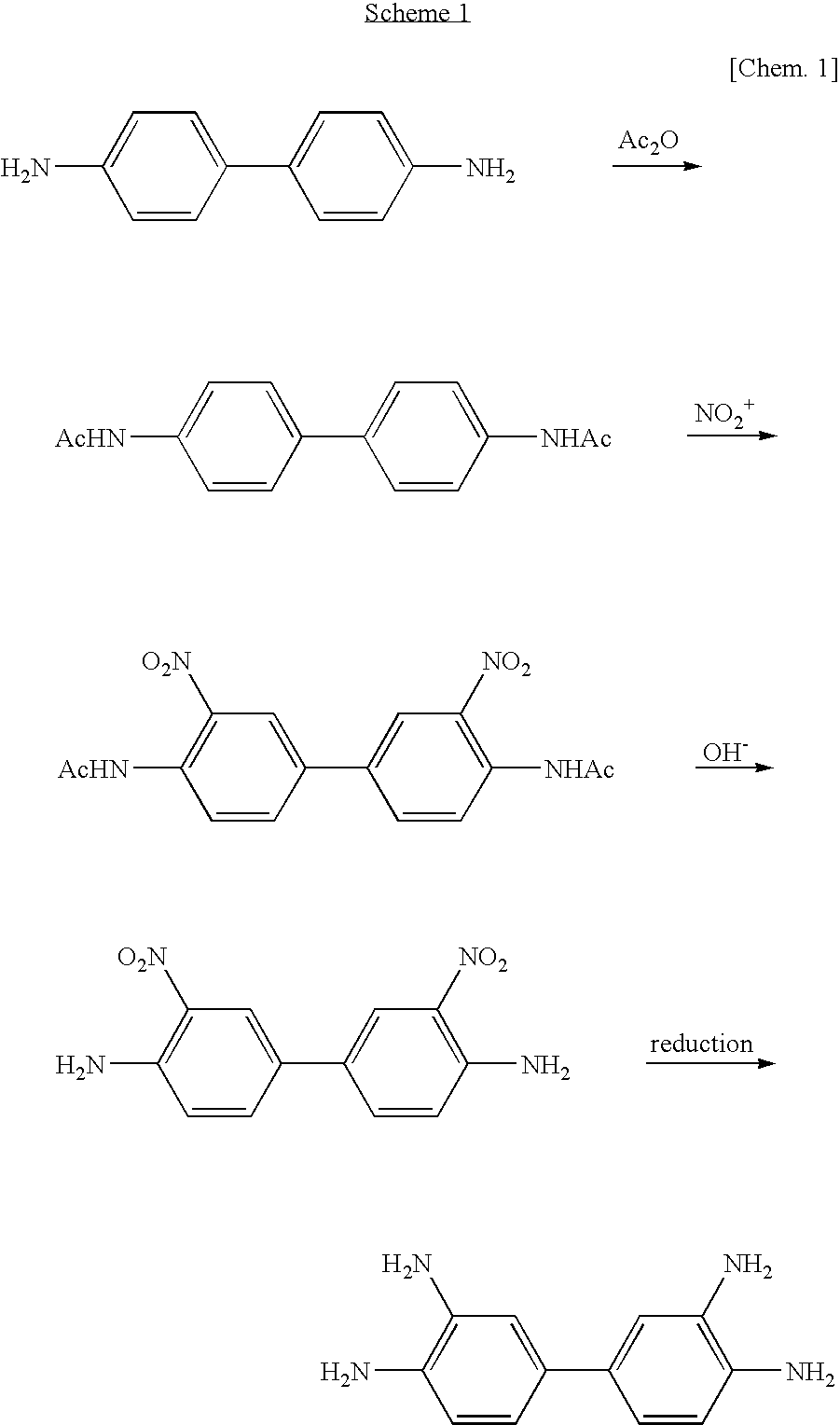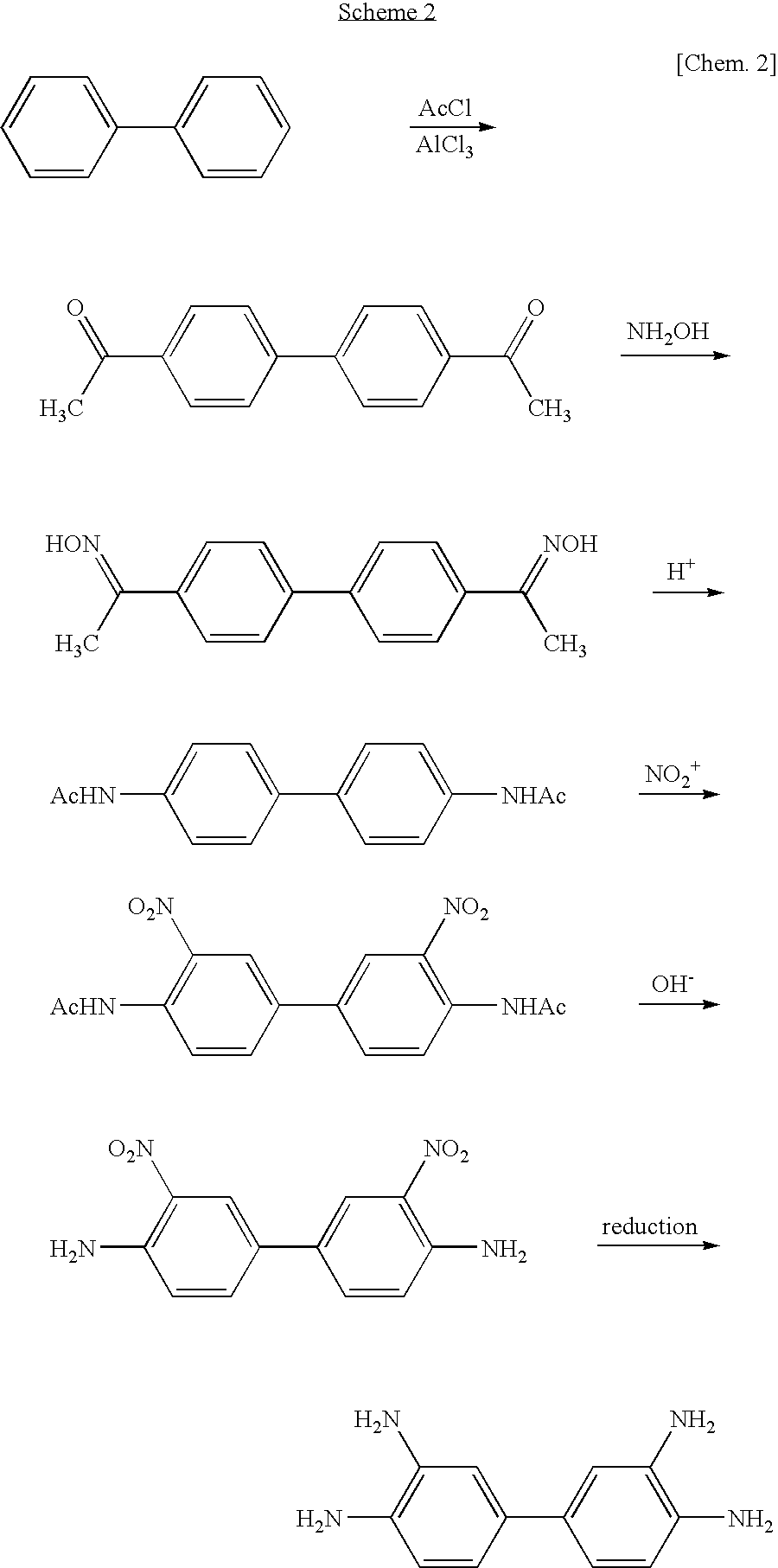Method of manufacturing 3, 3' , 4, 4'-tetraaminobiphenyl
a technology of tetraaminobiphenyl and tetraaminobiphenyl, which is applied in the field of manufacturing methods of 3, 3′, 4, 4′tetraaminobiphenyl, can solve the problems of deterioration of working conditions, special attention to deterioration, and inefficiency of above biphenyl methods, so as to improve working conditions and improve the effect of environment safety
- Summary
- Abstract
- Description
- Claims
- Application Information
AI Technical Summary
Benefits of technology
Problems solved by technology
Method used
Image
Examples
example 1
Synthesis of 5-chloro-2,1,3-benzothiadiazole
[0054]A mixture was prepared by mixing 4.0 g (28 mmol) of 4-chloro-o-phenylenediamine, 14 mL of thionyl chloride and 0.62 mL of concentrated sulfuric acid and was refluxed for one hour. This mixture was cooled and then poured onto ice, and a resultant precipitate was filtered and collected. This precipitate was washed with water till the waste water became neutral and then thoroughly dried to yield 4.6 g of 5-chloro-2,1,3-benzothiadiazole as a crude product (melting point, 50 to 54° C.; yield, 96%). This crude product was vacuum-distilled to yield a pure product of 5-chloro-2,1,3-benzothiadiazole (melting point, 54° C.; yield, 85%).
Synthesis of 5,5′-bis(2,1,3-benzothiadiazole)
[0055]A reaction mixture of 2.2 g (12.9 mmol) of 5-chloro-2,1,3-benzothiadiazole and 1.3 g (20.5 mmol) of copper powder was heated in 5 mL of dimethylformamide with stirring at 150° C. for 20 hours. This reaction mixture was cooled and then poured into water (40 mL), ...
example 2
Synthesis of 5-bromo-2,1,3-benzothiadiazole
[0057]A mixture was prepared by mixing 4.0 g (21 mmol) of 4-bromo-o-phenylenediamine, 14 mL of thionyl chloride and 0.62 mL of concentrated sulfuric acid and was refluxed for one hour. This mixture was cooled and then poured onto ice, and a resulting precipitate was filtered and collected. This precipitate was washed with water till the waste water became neutral and then thoroughly dried to yield 4.5 g of 5-bromo-2,1,3-benzothiadiazole as a crude product (melting point, 48 to 50° C.; yield, 96.5%). This crude product was vacuum-distilled to yield a pure product of 5-bromo-2,1,3-benzothiadiazole (melting point, 50° C.; yield, 86%).
Synthesis of 5,5′-bis(2,1,3-benzothiadiazole)
[0058]A reaction mixture prepared by adding 4.6 g (21.4 mmol) of 5-bromo-2,1,3-benzothiadiazole and 2 g (31.5 mmol) of copper powder to 10 mL of dimethylformamide was heated with stirring at 150° C. for 6 hours. This reaction mixture was cooled and then poured into wate...
PUM
| Property | Measurement | Unit |
|---|---|---|
| temperature | aaaaa | aaaaa |
| temperature | aaaaa | aaaaa |
| temperature | aaaaa | aaaaa |
Abstract
Description
Claims
Application Information
 Login to view more
Login to view more - R&D Engineer
- R&D Manager
- IP Professional
- Industry Leading Data Capabilities
- Powerful AI technology
- Patent DNA Extraction
Browse by: Latest US Patents, China's latest patents, Technical Efficacy Thesaurus, Application Domain, Technology Topic.
© 2024 PatSnap. All rights reserved.Legal|Privacy policy|Modern Slavery Act Transparency Statement|Sitemap



